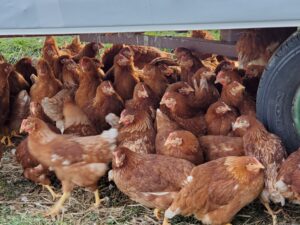Given the high costs of ‘commercial’ fertilizer components (N, P, K), many are looking at the range of nutrient credit from “unmanipulated animal or vegetable manure”1 sources.
Here is a very comprehensive calculator created by The University of Minnesota Extension for growers who keep track of all costs associated with fertilizer application.
To fine tune your estimates consider the following when calculating benefit of nutrients in manure vs fertilizer:
Manure nutrients are applied at a ton per acre rate basis to give the equivelent unit of nutrient in fertilizer that is applied at a pound per acre rate basis. Different species create vastly different nutrient credits.
On average,
Poultry manure contains the most nutrients per ton requiring the least tons per acre (1.5 to 3 tons/acre) to be equivalent to purchased fertilizer Nitrogen units of 50 lbs. (Please read the PPA post on poultry manure import restrictions due to High Path Avian Influenza)
Fresh beef manure generally requires 20 to 25 to 30 tons/acre to be equivelant to purchased fertilizer Nitrogen units of 50 lbs.
Fresh horse manure contains the least amount of Nitrogen and requires 100 tons per acre to be equivalent to purchased fertilizer units of 50 lbs, but as horse manure ages, the organic credit increases as the carbon:nitrogen ratio comes into equilibrium. Take this into consideration as aged piles many have much higher value.
- Use an actual analysis of composted, bedding manure or fresh manure
- Composted manure includes the shavings, straw, hay. Fresh manure is raw product, very little foreign material
- Test aged piles separately from fresh
- Aged piles (broken down, look like soil) can be sent in as soil test if well composted
- Fresh samples must be sent in as fresh manure, vented properly and packaged properly so they do not cause issues in transit. Read the laboratories instructions on shipping carefully
- Account for cost to ship samples to lab
- Capture in analysis the organic nitrogen credit
- Capture in analysis micronutrient credits as these trace minerals add value to ‘manure’ beyond just the major three nutrients (N, P, K).
- Know the common weed seeds most likely to be in fresh manure
- Know the common weed seeds most likely viable in aged manure
- Consider value of aged manure (organic nitrogen, soil health, worm castings, actual worms) vs fresh (hot) manure (higher N value)
- Account for moisture content in figuring rate per acre, tons per load etc. as analysis will be on a DM basis
- Laboratory fees range from $14.00 per test to $60.00 per test. Check current prices online before submitting sample, and use the laboratories submission form
- Consider transporation costs
- Consider spreading costs (manually vs manure spreader)
- Be aware of any restrictions (days since application etc.) on using fresh or unaged manure on crops that will be harvested for human consumption (fresh market etc.) in particular be aware of FSMA Final Rule on Produce Safety that states”the final rule as of 12/02/2021 requires that untreated biological soil amendments of animal origin, such as raw manure, must be applied in a manner that does not contact covered produce during application and minimizes the potential for contact with covered produce after application. For more information on this rule, see https://www.fda.gov/food/food-safety-modernization-act-fsma/fsma-final-rule-produce-safety
Footnotes:
For information on what constitutes sale of a commercial ‘fertilizer’ see https://www.nj.gov/agriculture/divisions/md/pdf/FertilizerLaw.pdf
An indepth fact sheet on manure can be found at https://ag.umass.edu/crops-dairy-livestock-equine/fact-sheets/manure-nutrient-resource
 The United States Department of Agriculture’s (USDA) Animal and Plant Health Inspection Service (APHIS) has confirmed findings of highly pathogenic avian influenza (HPAI) H5N1 in wild birds in South Carolina and North Carolina. Wild birds can be infected with HPAI and show no signs of illness. They can carry the disease to new areas when migrating. APHIS anticipates additional wild bird findings as robust wild bird sampling program continues into the spring. – For the full press release see the APHIS website.
The United States Department of Agriculture’s (USDA) Animal and Plant Health Inspection Service (APHIS) has confirmed findings of highly pathogenic avian influenza (HPAI) H5N1 in wild birds in South Carolina and North Carolina. Wild birds can be infected with HPAI and show no signs of illness. They can carry the disease to new areas when migrating. APHIS anticipates additional wild bird findings as robust wild bird sampling program continues into the spring. – For the full press release see the APHIS website. 